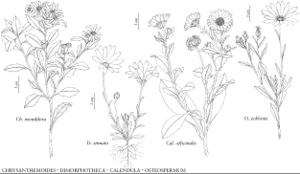Calendula
Sp. Pl. 2: 921. 1753.
Gen. Pl. ed. 5, 393. 1754.
| Taxon | Illustrator ⠉ | |
|---|---|---|
 | Chrysanthemoides monilifera Dimorphotheca sinuata Calendula officinalis Osteospermum ecklonis | Yevonn Wilson-Ramsey Yevonn Wilson-Ramsey Yevonn Wilson-Ramsey Yevonn Wilson-Ramsey |
Annuals, perennials [subshrubs], 5–50 (–70+) cm. Stems procumbent to erect, glabrous or arachnose and/or stipitate-glandular. Leaves sessile or petiolate; blades elliptic, obovate, or oblong to oblanceolate, spatulate, or linear (bases sometimes clasping), margins entire or denticulate, faces sparsely arachnose and/or stipitate-glandular. Heads borne singly. Involucres campanulate to hemispheric or broader, 10–30+ mm diam. Phyllaries 13–40+ in 2+ series, lanceolate to lance-linear. Receptacles flat. Ray-florets 13–50 (–100+) in 1–3+ series; corollas yellow to orange, laminae linear to oblanceolate. Disc-florets 20–60 (–150+), functionally staminate; corollas yellow, reddish, or purplish, tubes shorter than ± campanulate throats. Cypselae arcuate to ± coiled (usually some beaked, some 2–3-winged, some both beaked and winged), abaxial faces usually tuberculate and/or transversely ridged. x = 11.
Distribution
Introduced; Macaronesia, Mediterranean Europe, Near East, North Africa, widely cultivated, sometimes escaping and/or persisting
Discussion
Species 15 or fewer (2 in the flora).
Selected References
Lower Taxa
Key
| 1 | Phyllaries 13–21+, 6–10+ mm; ray florets 13–18+, corolla laminae 5–8(–12+) mm | Calendula arvensis |
| 1 | Phyllaries 12–40+, (8–)10–12+ mm; ray florets 30–50(–100+), corolla laminae 12–20+ mm. | Calendula officinalis |
"broader" is not a number.